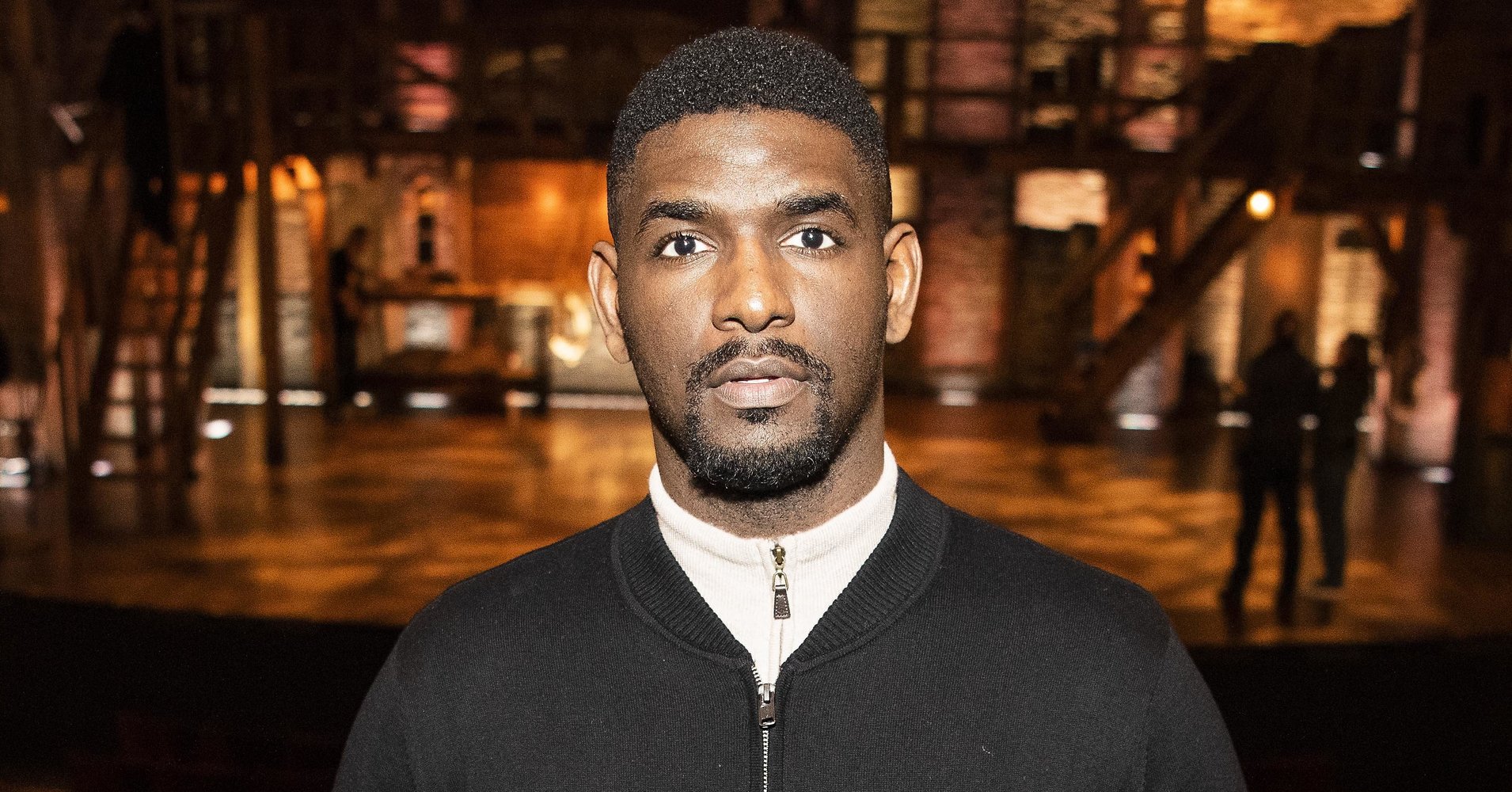[ad_1]
Carvens Lissaint is tired of having to prove he belongs in his own building. He’s a 6 foot 3, 29-year-old black man, raised in Harlem, and he lives in a new upscale glass residential tower in downtown Brooklyn. He moved there in September, the same month he landed a starring role in “Hamilton” on Broadway, one of the biggest hits in musical theater history. But again and again — five times in all, by his count — the rotating cast of security desk attendants treats him like an outsider.
“I come here with some Trader Joe’s groceries, about to cook my wife some dinner, and they’re like, ‘I’m sorry, deliveries are downstairs. You have to call up,’” he said. “They just see a black guy wearing Beats headphones, sweats and a hoodie. … I’m like, ’I live here. These are my keys.’”
Lissaint, the first-generation son of poor Haitian immigrants, is certainly new to this lifestyle. He was homeless in New York not long ago. Some nights, if he didn’t have a place to go, he would just ride the subway from end to end, writing poetry until the sun came up and performing it for cash. Now the spoken-word poet earns six figures playing George Washington in a Broadway musical that reimagines America’s white Founding Fathers as men of color, rapping about the Revolutionary War and creation of the U.S. government.
Lissaint’s success in some ways recapitulates the narrative at the heart of “Hamilton,” the story of the scrappy underclass bootstrapping itself into the American dream. This is a complicated thing to reckon with, the child of Haitians playing a white colonist who owned 123 slaves. “In a lot of ways, I’m playing this character in honor of the people who were Washington’s slaves, by reclaiming the narrative and letting it be told through this Haitian black man,” he said. “When people see me play him, it challenges how we think of who has the ability to run this country.”
At the same time, the portrayal in “Hamilton” of an American meritocracy run on grit and perseverance is a myth, especially for people of color. Now that he has a platform, Lissaint has some things he’d like to say about his experience of racism, even if it means implicating some of the people in the seats at the Richard Rodgers Theatre.
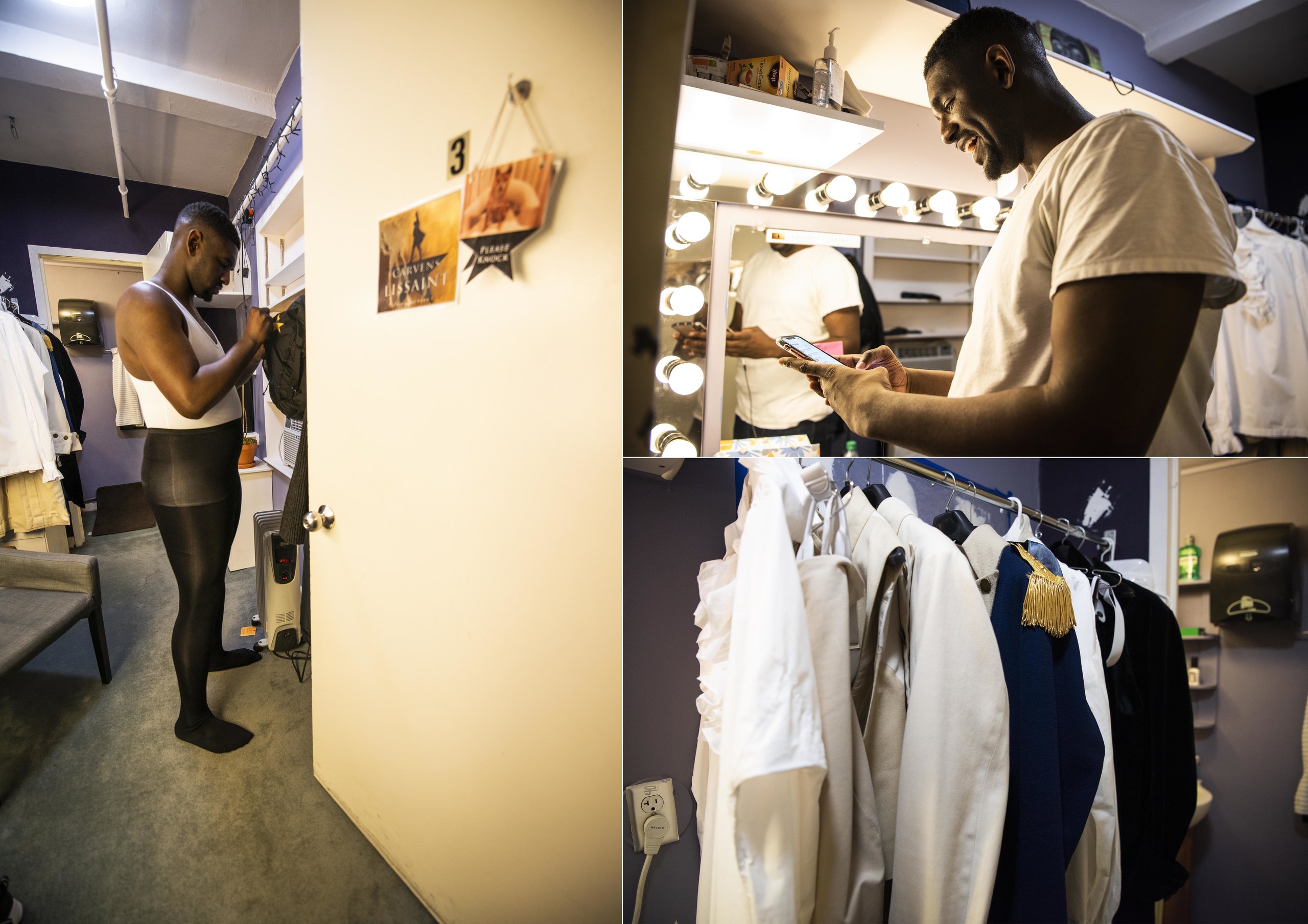
Damon Dahlen/HuffPost
Backstage at the theater on a Wednesday in November, Lissaint showed me his tiny blue dressing room before a matinee of “Hamilton.” Broad-shouldered and baritone-voiced, he fills up any space he’s in. He seemed a bit out of place in this one, standing there in black tights next to a rack of colonial attire ― white ruffled collars, breeches, velvet coats with tails and gold tassels, the cocked hat of a Revolutionary War general. He scrolled through his iPhone looking for a gospel song to play. This is his ritual, eight times a week; sometimes he dresses to worship music, “sometimes ratchet music,” he said, depending what kind of energy he needs.
Taped to the mirror in front of him was a handwritten quotation by Washington: “I hope I shall possess firmness enough to maintain what I consider the most enviable of all titles, the character of an honest man.” Christopher Jackson, the actor who originated the role in “Hamilton,” first posted the note in his dressing room, and it has remained there for each new Washington who cycles through.
The actors burn out relatively quickly, because it’s a demanding role and the “Hamilton” schedule is brutal: It runs eight times a week, including two double-show days, as most Broadway shows do. The cast gets only Mondays off. Lissaint has a litany of back and leg injuries that have him limping around the theater most of the time. He goes to physical therapy before almost every show and then undoes all the healing with constant dancing and moving onstage. He’s exhausted and aching and has zero time for a social life. But a particularly tough graduate acting teacher taught him that the No. 1 rule of theater is to always show up unless you’re literally on your deathbed.
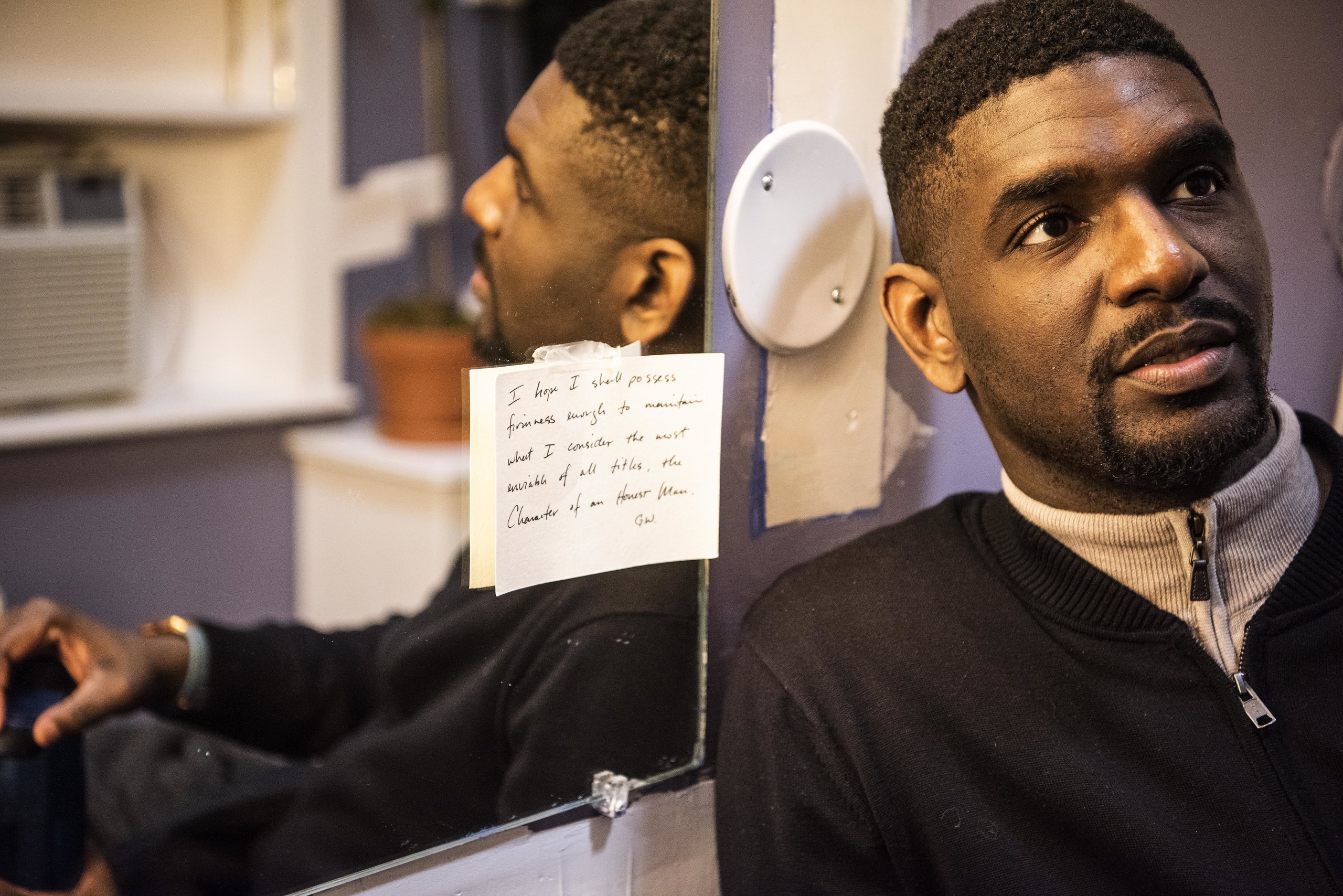
Damon Dahlen/HuffPost
“That’s why I can get up on that stage with three herniated discs, an inflamed quad tendon that feels like it’s about to rip every day and an anterolateral impingement in my ankle and be like, ‘Welp, I’m here,’” he said.
That he is here at all is something of a wonder.
Lissaint’s parents immigrated to the borough of Queens in New York in 1979 from rural Haiti. His father is a desk attendant at Barnard College, his mother a nurse. Lissaint is pretty sure they were trying to name him Kevin ― they always called him K ― but in his dad’s thick Haitian Creole accent, it came out sounding like Carvens, and someone spelled it that way on his birth certificate.
Lissaint learned early from his father what it meant to be black in a white world. “I remember watching these cops beat up on Rodney King when I was 3 years old,” he said, referring to the 1991 police brutality episode in Los Angeles. “My dad said in his deep accent, ‘This is the way it is. They’re coming for us. This is the beginning.’”
There’s a scene at the beginning of “Hamilton” in which Aaron Burr warns his friend Alexander Hamilton to watch his mouth, foreshadowing their fatal duel at the end:
Burr: Talk less.
Hamilton: What?
Burr: Smile more.
Hamilton: Hah.
Burr: Don’t let them know what you’re against or what you’re for.
Hamilton: You can’t be serious.
Burr: You wanna get ahead?
Hamilton: Yes.
Burr: Fools who run their mouths off wind up dead.
The message is familiar to Lissaint, who said he has been told his whole life that his words could be his downfall. His dad tried to teach him how to protect himself as a kid by blending in, by sounding more like a white person. “My dad used to slap me upside my mouth when I used slang,” he said, then slipped into a Haitian accent. “I don’t want them to look at you like you’re a threat. I don’t want them to look at you like you’re uneducated. If you say ‘yo,’ that means they’re going to take away your job.”
The warning had some truth to it. Lissaint was a wholesome kid, playing basketball, joining the salsa dance team in high school, competing at poetry slams, singing in the choir ― but the police would harass him for no good reason. “Walking in uptown Manhattan with my high school basketball team, the cops would assume we were a gang going to fight other gang members, and we would get randomly pulled over and thrown on a wall,” he remembered.
His senior year of high school, his parents fell into debt, and his family of four had to move into his grandmother’s one-bedroom apartment in Harlem. His mom and sister slept on a mattress next to his grandmother’s bed, while he and his dad crashed on a sofa and futon in the living room.

Courtesy Carvens Lissaint/”Hamilton”
Lissaint always struggled with traditional academics, knowing he wanted to be a performance artist. He enrolled in community college ― mainly to have a dorm to sleep in ― and flunked out after his first year. He wanted to be an artist and had already found some success as a spoken-word poet, despite his dad’s repeated warnings to ignore poetry and “get a job that pays the bills.” His dad went so far as to forbid him to attend poetry slams in high school, but Lissaint competed anyway and won the acclaimed New York Knicks Poetry Slam in 2007 at 18 years old. He won several more in the next two years and eventually began coaching slam teams and mentoring young poets.
Poetry wouldn’t pay the bills, though, at least not yet. He crashed on friends’ couches or rode the subway all night for about three years after community college. He would perform on the train to scrape together enough cash to see his favorite Broadway show, “In the Heights,” again and again. The musical, written by “Hamilton” playwright Lin Manuel Miranda, opened on Broadway in 2008, also at the Richard Rodgers Theatre, also starring Jackson, one of Lissaint’s heroes.
“In the Heights” is a love letter to Washington Heights, a Hispanic neighborhood in upper Manhattan. Lissaint was transfixed. He saw the play 13 times. Sometimes his friends would give him a ticket, knowing how much he loved it. “Chris Jackson is the reason I started acting,” he said. “I was a young black kid from upper Manhattan. To see a musical about Washington Heights and see a black dude onstage, that was inspiring.”
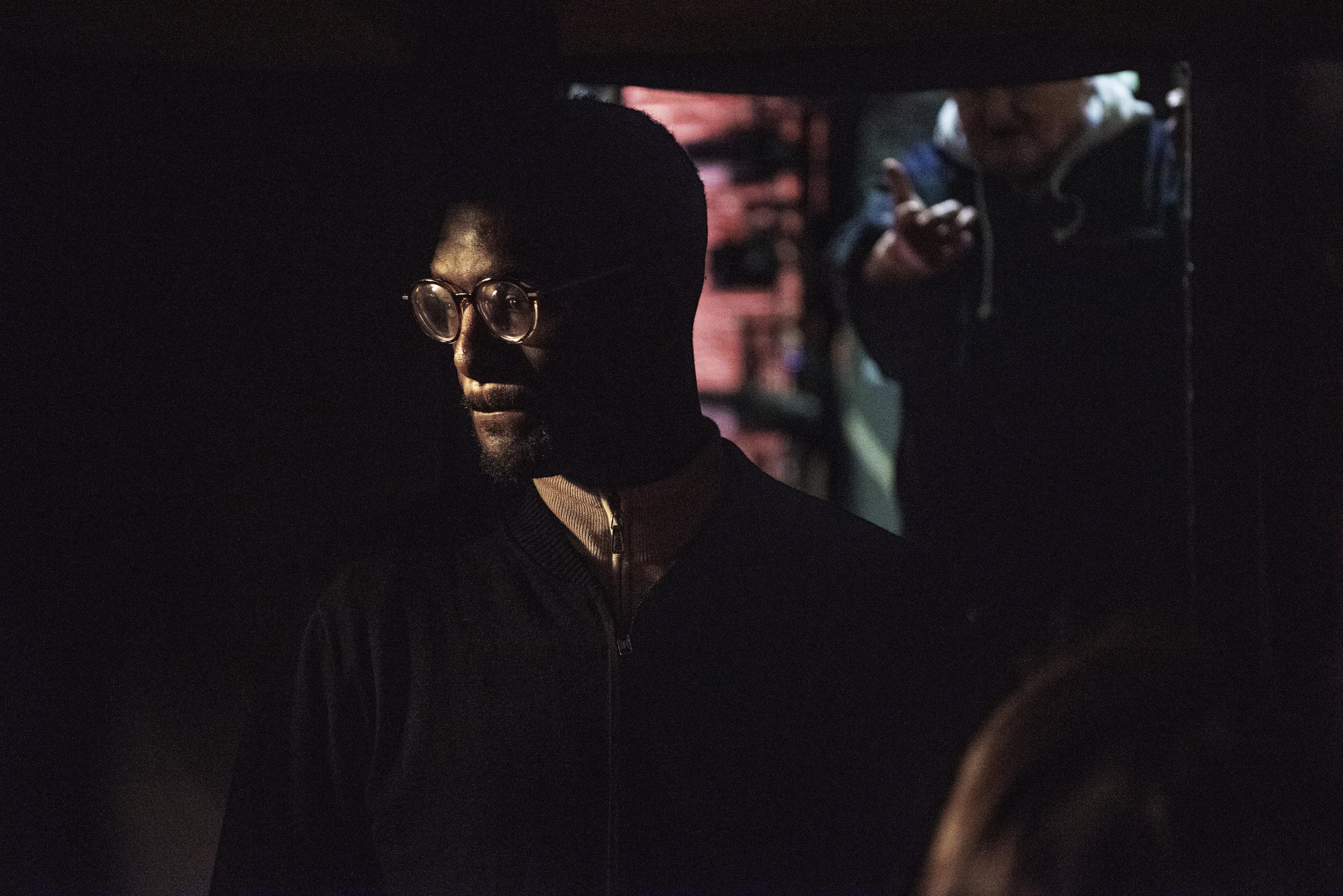
Damon Dahlen/HuffPost
At 20, Lissaint had another terrifying encounter with the police. He was riding in a car with three black friends to an arts party in New Jersey, where people were playing guitar and rapping and making music together. A policeman pulled them over for allegedly making a turn that was too wide. The cop forced them out of the car and searched it, claiming there was a scent of burned marijuana in it, though Lissaint insists none of them had smoked or had any drugs on them. His friend Miles was angry at the injustice of the situation and started cussing, which prompted the policeman to call for backup, and five more squad cars showed up with dogs, Lissaint recalled. The officers approached Lissaint and his friends with guns drawn, though he and his friends were unarmed.
Lissaint had a sick feeling he could die that night. “I was sitting there, like, yo, they could kill us,” he said. “They could kill us right now, and we can do nothing about it.”
He was homeless for two and a half years before he started auditioning at conservatories, hoping one of them might see his potential and give him a scholarship. He got a callback from Juilliard in 2010. New York University’s acting program had accepted him, but he couldn’t get into the main school with his academic record. Ultimately, he was able to enroll at the American Academy of Dramatic Arts in Manhattan and transfer to St. Johns University with a full ride.
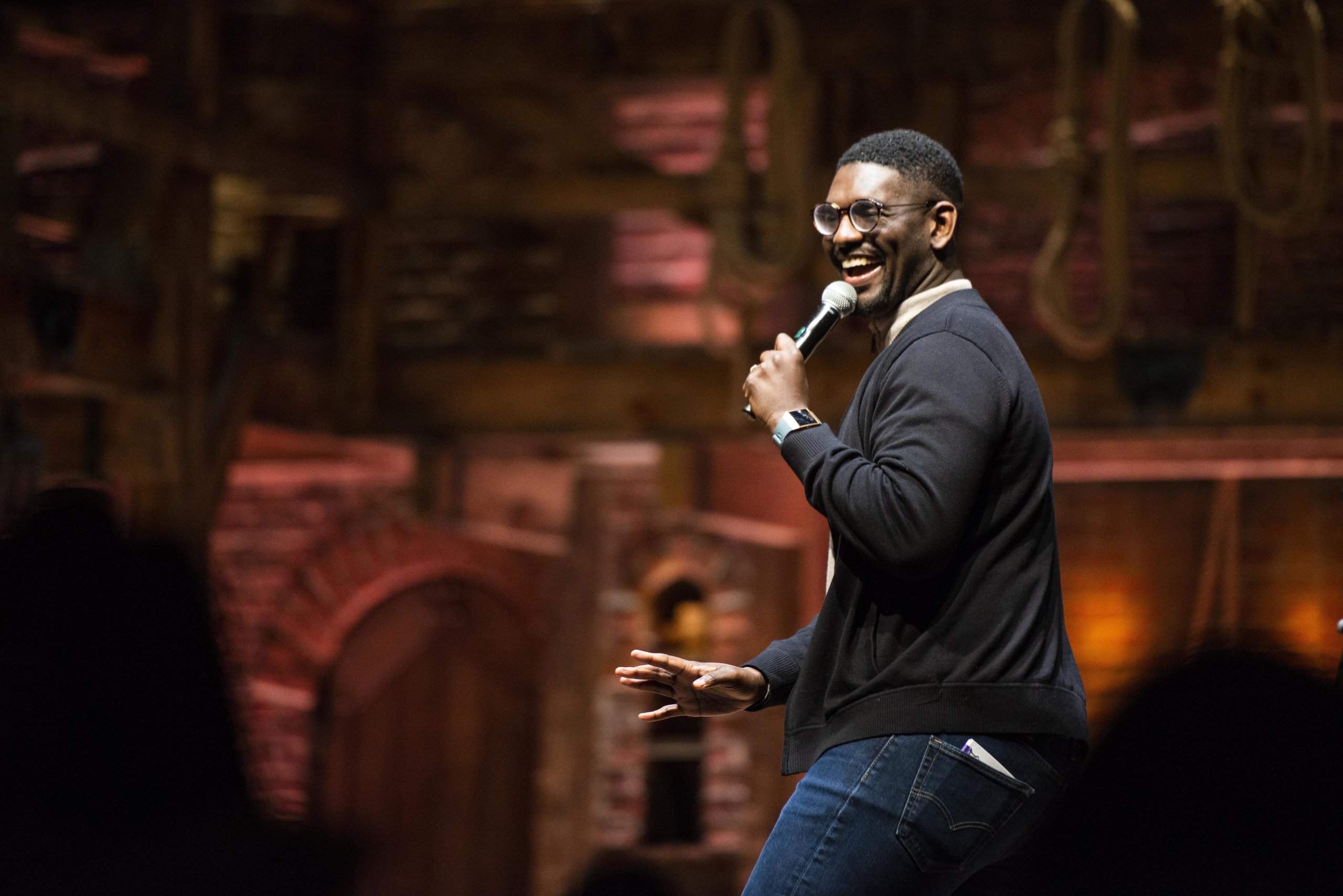
Damon Dahlen/HuffPost
It was there that he began to understand that high art was generally considered to be art created by white people ― and that black people’s art forms and aesthetics aren’t as valued pedagogically or considered worth investigating in the theater and academic worlds.
“A teacher would say, ‘Bring in a piece of high text,’ and I would bring in a spoken-word poem or a rap. And they’d say, ‘No, we mean high art, like Shakespeare,’” Lissaint said. “Voice and speech teachers told me, ‘You should stop doing spoken-word poetry, it’s inspiring your regionalism and your dialect too much. We’re afraid you’ll never be able to work in the American theater because of your speech, because you do that rap thing.’”
He showed them that he could do it all. He can do a posh British accent as well as rural Haitian Creole. He can adeptly perform Chekhov or Shakespeare or a battle rap onstage. So in 2014, after finishing his undergraduate degree, he was accepted into NYU’s graduate acting program ― regarded as one of the best in the country.
Before he even finished that program in the spring of 2017, he was getting callbacks for “Hamilton.” The show perfectly suited his talents. “It’s not the story we’re telling but how we’re telling it that I’m fascinated by,” he said of the musical. “Rap has all elements of heightened text ― hyperbole, rhyme scheme, everything you’ll find in Shakespeare or a Greek tragedy.”
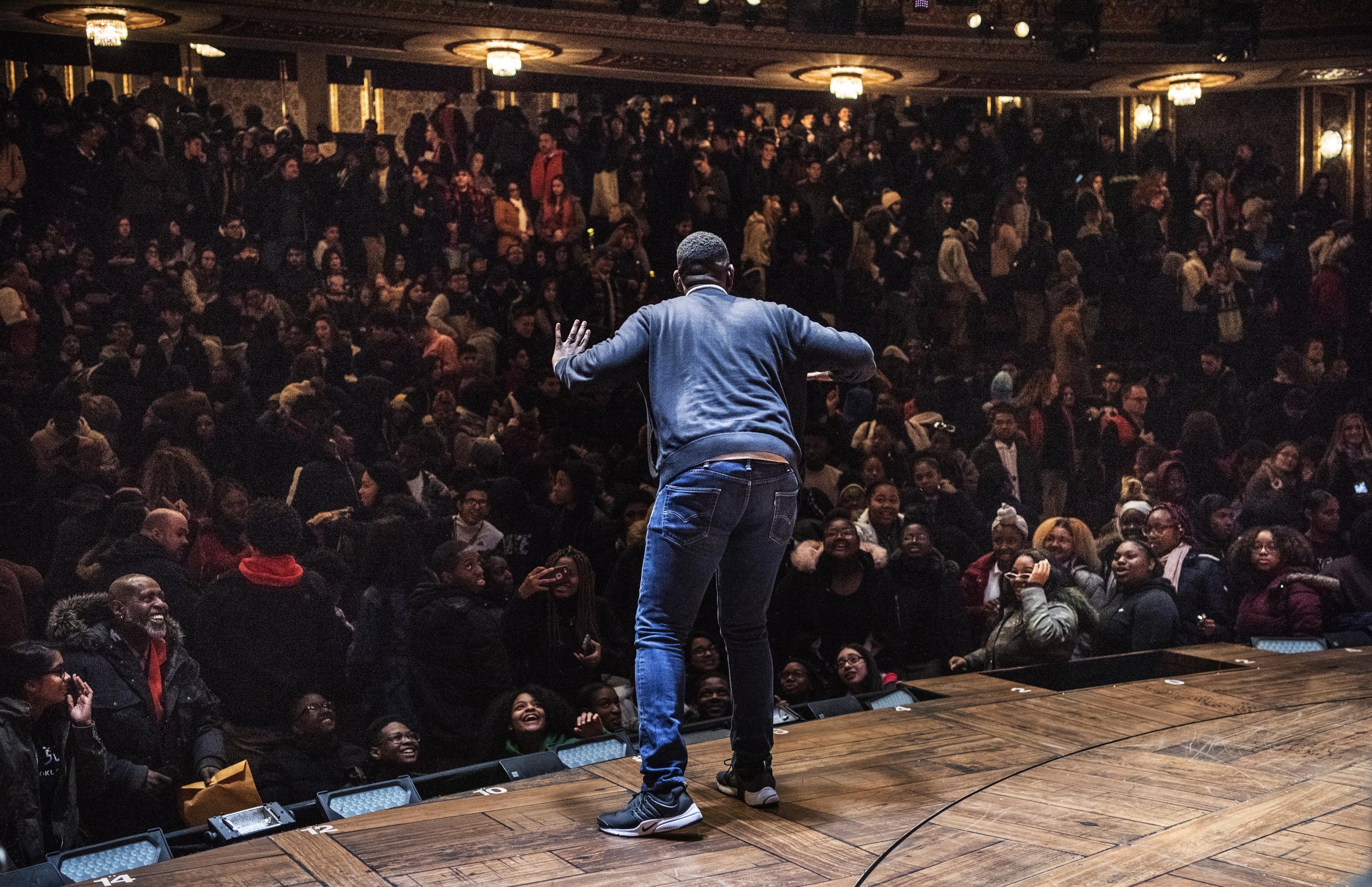
Damon Dahlen/HuffPost
Lissaint started as a standby on Broadway for the three lead roles of Aaron Burr, Washington and the Marquis de Lafayette/Thomas Jefferson, then joined the show’s national tour as Washington in April 2018 and landed the principal role on Broadway in September.
He feels a kinship to his character, despite their obvious differences. They’re both men of stature, both called to lead, both survivors. At the Battle of the Monongahela in 1755, Washington had two horses shot out from under him and found four bullet holes in his coat, but somehow he emerged unscathed. “Bullets would just whiz past him,” Lissaint said with a tinge of awe and respect. “He seemed untouchable.”
While the story of “Hamilton” centers on the conflict between Hamilton and Burr, Washington is a particularly attention-grabbing character. He anchors the choreography. When he moves around onstage, the other characters move out of his way. And Lissaint’s naturally strong presence makes that dynamic believable.
Lissaint’s parents went once to see the show in 2017, when Lissaint was playing Washington as a standby. Here at last was a chance for his father to see his son commanding the stage, filling the whole theater with his presence — a successful artist. “My father wept in my arms at the stage door for a good minute and a half,” he said. “He wept uncontrollably and held me. It was probably the first time he’s ever held me like that in his life.”
The week after Thanksgiving, Lissaint and I ate Thai takeout in the chic, minimalist living room of the new 15th-floor apartment he shares with his wife, Leslie Lissaint. Soft piano jazz music emanated from the flat-screen via Apple TV; floor-to-ceiling windows showcased sweeping views of downtown Brooklyn. He said he chose the neighborhood because it’s close to his church, which asks him to go in and preach sometimes.
The apartment is by far the nicest place he has ever lived, but he can’t shake the sense that this situation is only temporary. “As much as I love this, I can’t really enjoy it,” he said. “I know it’s not forever, because ’Hamilton’ [is] not forever, and I can only afford to live here because I’m in ’Hamilton.’”
Carvens Lissaint wears his gray “Hamilton” T-shirt everywhere now — at home, to the store, to Dunkin’ Donuts to order a jelly doughnut. He had it on when I interviewed him. He finds that people treat him better when he’s wearing it. But even now, on the same day that white people give him a standing ovation in Broadway’s most prestigious theater, he inspires fear in them on the sidewalks.
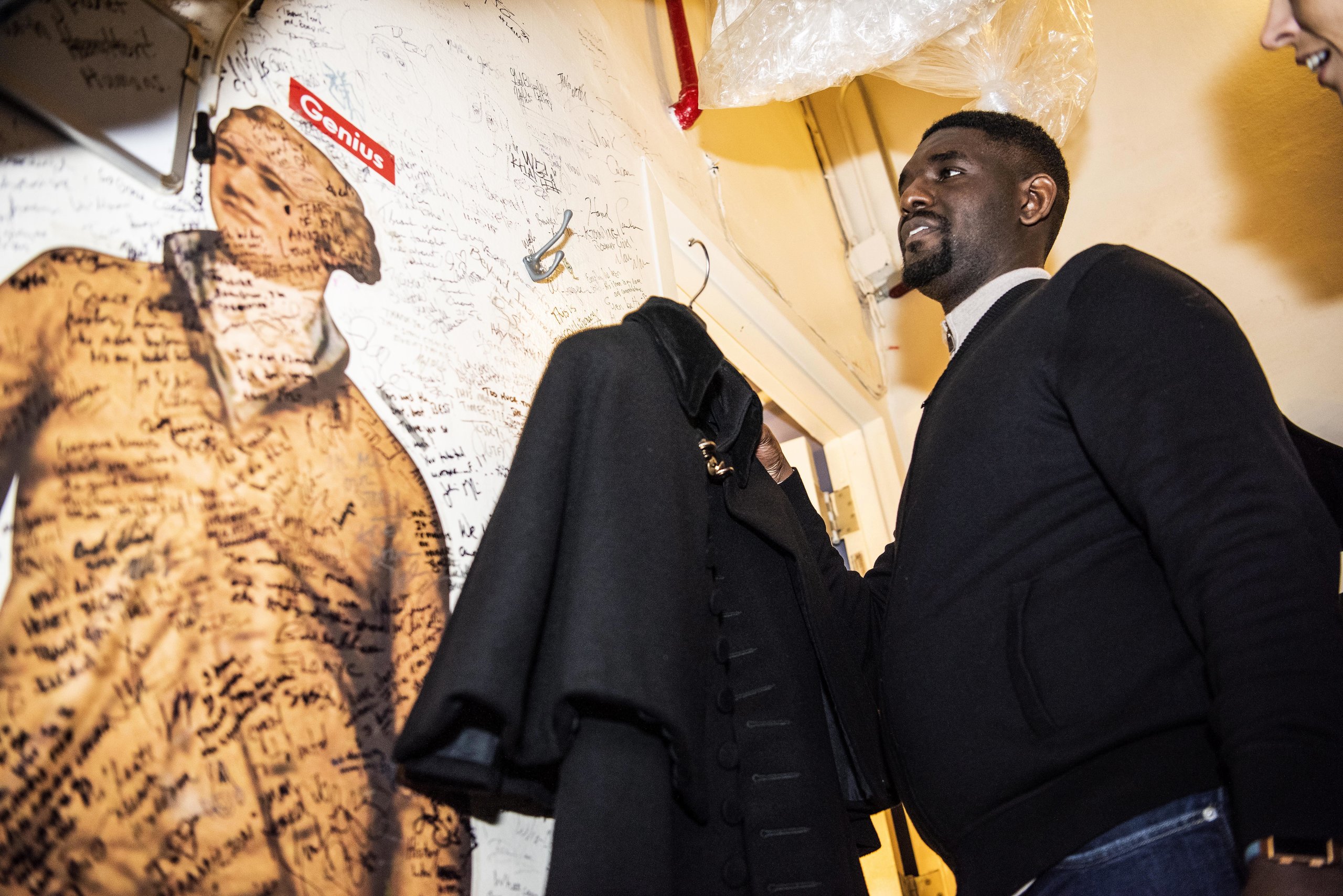
Damon Dahlen/HuffPost
“I’m a dude from the hood who has three degrees from three well-known institutions. I’m in the hottest place in my field, in terms of theater. And I walked by a white woman two months ago who grabbed her purse in fear,” he said. “Two months ago!”
Aside from a few pieces of furniture and the occasional video game, Lissaint is not buying much with his new six-figure salary. He said he still has a “poverty mentality.” He offered me a glass of red wine ― someone gave him a bottle as a housewarming gift ― but then he realized he doesn’t even own a corkscrew, so I drank water.
I asked Lissaint what it’s like to go from being homeless and sleeping on friends’ couches to having this fancy apartment. “My wife was trying to get me a gift, and she asked me what I want,” he said. “I’ll tell you exactly what I want.”
He leaped from the couch, crossed to the wall and started flipping the light switch on and off, creating a strobe effect in the living room. “You see that? The lights work!” he shouted, his voice becoming louder and more performative. “That’s dope to me! I don’t need much! That is dope! You see this? The lights are on! I don’t need much!”
Instead of buying things, Lissaint has decided to use his new Broadway money and platform to make a five-track album and a book of poetry about racism and violence against black bodies. He realized while he was in grad school that performing art solely for entertainment’s sake wasn’t going to fulfill him. “I’m sitting in class doing Shakespeare monologues, and Trayvon [Martin] just got killed, and we see a Black Lives Matter march pass by our rehearsal. And I’m like, what am I doing in here?” he said.
Lissaint’s new projects, both called “Target Practice,” draw from his experiences and reflect on stories like that of Philando Castile, a black man who was pulled over by police in Minnesota and fatally shot in front of his girlfriend and her child in 2016. The poems pulse with outrage at the white ruling class, even implicating his Broadway audience. Lissaint plays with form and often breaks it, putting traditional sonnets alongside blasting battle raps. “The Great White Way” is a crown of sonnets, eight poems of 14 lines each, in which the last line of each sonnet is echoed the first line of the next. It’s about the racism he has witnessed while working on the show. And because he used a more rigid form, he wanted to be especially raw in the lyrics.
Fascinating, the same people
who gave me a standing ovation
wouldn’t rise to their feet & scream
if I were killed right here. Wouldn’t bat
an eye if I lived beneath the gravel
they walk on every day. I matter on
the platform, murdered in the shadows.
As if a theater credit would reverse a bullet
back into its chamber, sweet talk trigger from
retracting, or un-spark the flash from its muzzle.
How they stay blind to the arrows pointed against us.
He refers specifically to an incident on July 4, when he posted a photo on Instagram of an 1852 speech by Frederick Douglass about “The Meaning of July Fourth for the Negro” and the fact that Americans were celebrating freedom while keeping African men enslaved. Douglass’ speech, one of the most damning pieces of oratory in American history, condemns the display of patriotism on Independence Day as “hypocrisy — a thin veil to cover up crimes which would disgrace a nation of savages.”
Lissaint now has 11,000 followers, and a white woman who described herself as a “Hamilton” fan commented on his post, “This would definitely make sense to an African American male in the 1800s. Not so much to an African American male who makes his money in 2018 singing in a play based on American history. You are very talented and one of my favorite actors in the play. This post, however, is offsetting.”
Lissaint points much of his poetry at people like her who seem oblivious to ongoing racial oppression in this country. “There are ’Hamilton’ fans who don’t like black people,” he told me matter-of-factly.
He said white people after the show will demand that he pose with their kids or yank him around for pictures like he’s a prop, instead of just asking him. One woman in Houston grabbed the “Hamilton” backpack on his body and twisted it around to show it to her friend, without ever acknowledging the man wearing it. “When you’re an artist, people feel like they own you,” he said. And when you’re a black artist ― “that has deeply rooted implications.”

Damon Dahlen/HuffPost
These are brave things for a Broadway actor to say about his audience, and Lissaint is naturally a bit nervous about how his messages will be received by the commercial theater. While Broadway stages are becoming increasingly diverse, with relatively new shows like “Hamilton” and “American Son” giving the appearance of inclusivity, the people who run Broadway, who profit from it and who pay to see its shows are still vastly white.
There are only a handful of black writers and directors working on Broadway. White people own the 41 Broadway theaters, and their audiences are 75 percent white, with an average household income of $222,120, according to a report released this year by the Broadway League. Fewer than 3 percent of Broadway patrons are black.
The wealthy theater community in New York is broadly progressive, but there are limits to its political commitments. Historically, Broadway has been more inclined to elevate certain political issues and causes over others. “They are extremely supportive and very open about LGBT rights, and that’s fantastic,” Lissaint said. “But I do think certain marginalized groups aren’t really talked about.”
The Broadway community has a long history of supporting gay rights because it has traditionally been a mecca for the gay community. The nonprofit Broadway Cares/Equity Fights Aids has raised nearly $300 million for people living with HIV/AIDS since its founding in 1988, during the worst of the epidemic. Lee Seymour, who covers Broadway for Forbes, said there simply hasn’t been as much interest on Broadway in issues of racism because it hasn’t been as relevant to the people behind the curtain.
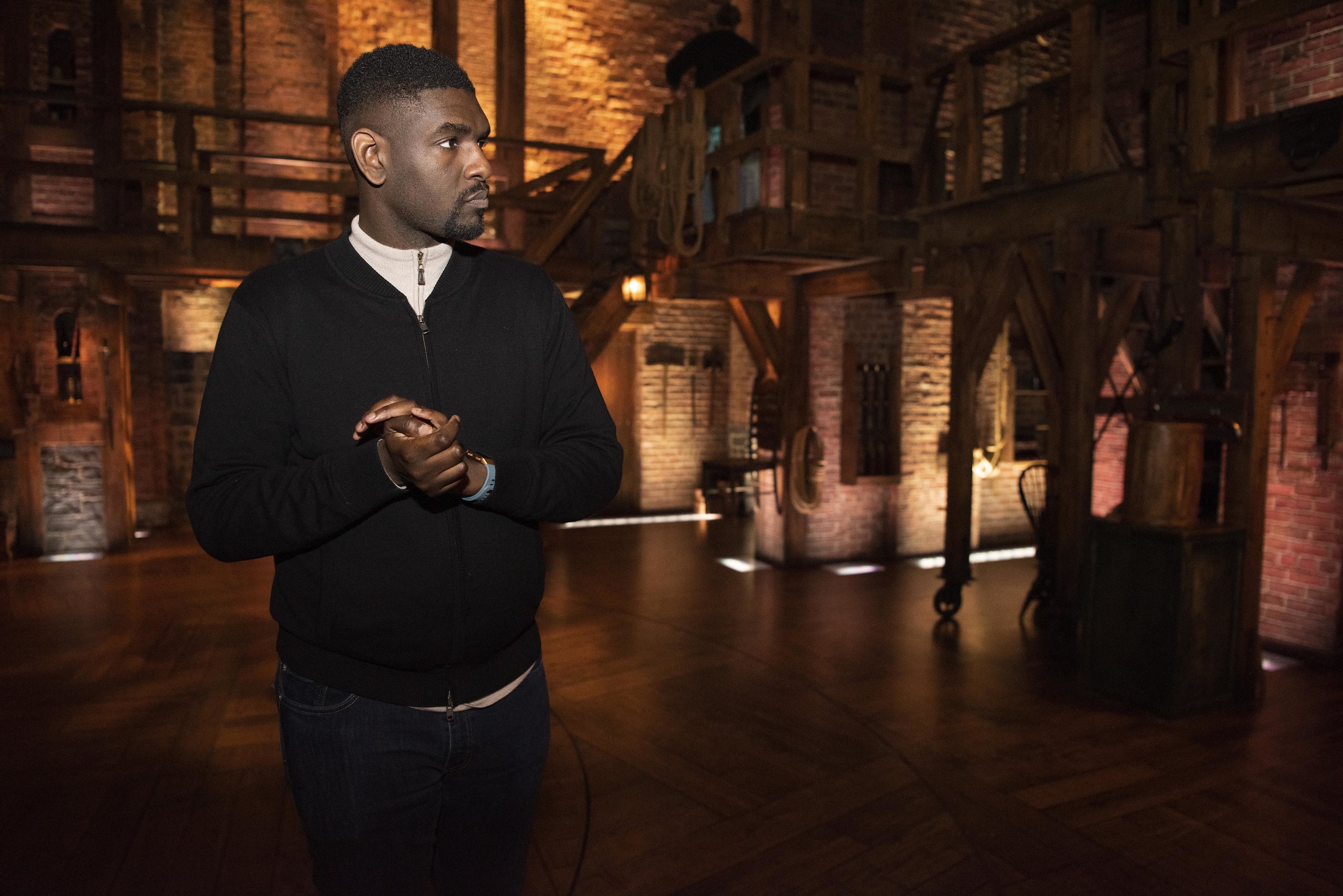
Damon Dahlen/HuffPost
“Broadway was disproportionately gutted by how many men died and how many leaders and people involved died in the AIDS epidemic,” he said. “But historically it hasn’t been a place that, for the most part, saw the plight of black Americans with the same intimacy and clarity as it saw the plight of queer Americans, because there weren’t as many embedded in the industry.”
And because Broadway relies on a largely white audience for its revenue, there is always the concern that some will be turned off by a political message that directly implicates them.
“There is some white guilt in theater audiences, those who want to say, ‘I am part of the problem as a white person consuming culture. I feel this is bad, and I want to see something that will affirm that,’” he said. “And there can also be the defensive ‘I’m not a part of the problem, hashtag NotAllMen, NotAllWhites’ aspect. That tension bubbles up sometimes in white audiences that see themselves as good progressives, which is why you see less embracing of racially oriented social justice issues. There’s risk of a bigger backlash.”
Broadway became Broadway in part by distancing itself from the lower social orders. The first Broadway theaters were established in lower Manhattan in the early 19th century, and they migrated north toward Union Square and then Madison Square and Herald Square in later decades to avoid crowded immigrant neighborhoods. Electrical lighting was installed toward the end of the century, and thus the Great White Way was born.
Until the Harlem Renaissance in the 1920s, many theaters were whites-only, or they relegated black patrons to a special section in the back. But even as theaters and casts of Broadway shows became more integrated and colorblind throughout the civil rights movement, the commercial theater’s politics lagged behind the movement. “While important victories were being won by black activists, the concerns of black Americans did not immediately translate into Broadway productions that explored serious black issues,” historian Stewart Lane writes in Black Broadway: African Americans on the Great White Way. “Theater owners and producers were not sure how audiences would react to black shows, so they stuck with proven commodities ― lavish musicals, most of them with white casts.”
The idea that African-American plays and musicals are financial risks has been proved wrong over and over again since “A Raisin in the Sun” filled theaters and won four Tony Awards in 1959, but it lingers on Broadway, even today. “We still have a finite number of theaters, and you still have the fear of producers that the plays will fail. It’s a growth process,” said Kenny Leon, one of two black directors regularly working on Broadway. Leon directed the currently running “American Son,” about an interracial couple at a Florida police station, and he directed the wildly successful revival of “A Raisin in the Sun” starring P. Diddy in 2004.
Seymour said more conversations about race and diversity have started to happen behind the scenes since Donald Trump’s election and the extrajudicial police killings of black men lay bare the structural workings of racism in America. A coalition of artists started the Broadway for Black Lives Matter Collective, which put on one event for Black Lives Matter ― a concert in August 2016. They offered to help Feinstein’s/54 Below, a venue owned by four Broadway producers in the basement of Studio 54, put on a second concert the second month. The venue canceled the event, however, citing in an email a plank of the Black Lives Matter platform that “accuses Israel of genocide and endorses a range of boycott and sanction actions.”
“Feinstein’s/54 Below would have preferred to hold the concert in support of the #BlackLivesMatter movement, without endorsing or appearing to endorse the entirety of the Black Lives Matter organization and its platform but we’ve found that a distinction impossible for us to effect,” the venue’s owners said.

Damon Dahlen/HuffPost
That seems to have marked the end of Broadway’s overt activism on matters of race, although “Hamilton” has since ruffled some feathers. Brandon Victor Dixon, who played Burr in 2016, made headlines after the 2016 presidential election when he spoke directly to incoming Vice President Mike Pence in the audience after a show instead of taking a bow. Dixon’s speech was pretty mild. “We, sir — we — are the diverse America who are alarmed and anxious that your new administration will not protect us, our planet, our children, our parents, or defend us and uphold our inalienable rights,” he said. “We truly hope that this show has inspired you to uphold our American values and to work on behalf of all of us.”
Pence stood and listened to Dixon, later saying in an interview that he “wasn’t offended” by the remarks. But Trump attacked the show on Twitter as being “overrated” and said the cast should apologize for its “terrible behavior,” which sparked the conservative outrage campaign #BoycottHamilton. (The show didn’t suffer financially.)
Whether the actors break the fourth wall or not, everything about “Hamilton” is political and a commentary on race. The casting of the Founding Fathers and their love interests as people of color and the show’s emphasis on the role of immigrants in the founding of the country are especially noteworthy at a time of virulent racist reaction, much of it emanating from the White House. There’s a moment in the show when Hamilton and Lafayette sing, “Immigrants: We get the job done,” that usually draws so much applause on Broadway that Miranda reportedly had to write in an extra two bars of music after it so the lines that follow aren’t drowned out by cheers.
But that’s Broadway. Lissaint said the line didn’t always draw applause when he was on tour with the show outside New York. In Washington, D.C., the weekend of the Unite the Right rally, he heard people in the audience sigh and groan at the line. Some of them had already left. “Older white people come in thinking they’re seeing a show about history, and a black George Washington comes on,” he said. “You can see their faces ― confused, disgusted. People would just get up and leave.”
“I call ’Hamilton’ an insurgent,” said Dixon, who stars in the musical “Rent” on Fox airing later this month. “He walks into your heart as Hamilton or as George Washington, who were venerated and idealized, but once he gets in there, he raps to you like Wu Tang. He talks to you like a young immigrant that grew up in Washington Heights. “Hamilton” is designed to walk you into his home and tell you the truth.”
Lissaint’s verse is not meant to be as universally palatable as Miranda’s. His truths are harder. He describes the black body in “Target Practice” as being “merely a piñata for bullets,” a “canvas of crushed melanin to hang in your museum.”
You like us that way don’t you? Hanging lifeless.
Squeezed like fresh berries dripping with the
sweetness you so desire. A black body is only celebrated
when it is filled with holes. Seedless & permeable at its core.
We are the strangest of fruits treated like the rind of an orange
easy to peel off the face of the earth.
Dixon said he understands why Lissaint is nervous to put these words out there from his perch on Broadway.
“I thank Carvens, and I understand his fear about how these things will be received,” he said. “Defense for black bodies is never positively received. I encourage him to put the work out, represent the work, encounter people who might feel uncomfortable with the work and try to engage them with honesty.”
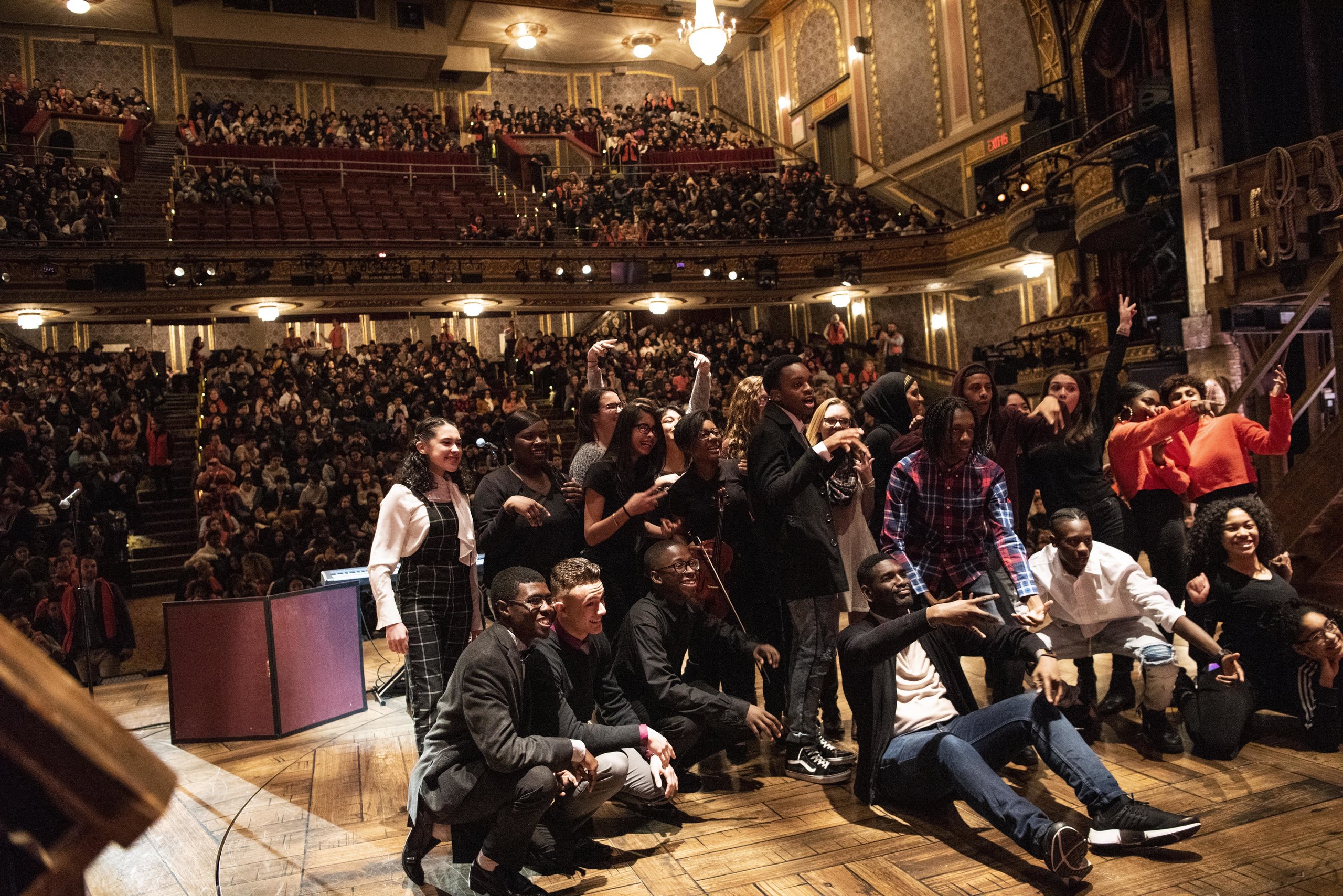
Damon Dahlen/HuffPost
If Lissaint ran Broadway ― a job he wouldn’t want if it existed ― one thing he would like to do is find a way to make more cheap tickets available to people who couldn’t otherwise afford to see his shows. “Hamilton” has one program, called EduHam, that does just that once every few months.
When I visited Lissaint backstage on Dec. 5, local high school students were crowded into the theater to see the matinee, having paid only $10 each for tickets that normally cost hundreds. That morning, a handful of them had been invited onstage to perform theater pieces they’d written about American history. Lissaint emceed the event, firing up the teenagers from the stage with the call-and-response style of a preacher.
One girl forgot her lines for a minute or so and froze, looking mortified in front of her classmates. Lissaint hovered in the wings like a protective father, trying to decide whether to go out and help her, but she eventually recovered on her own and made it through the piece. He demanded extra applause for her when she was done, and he used the moment as motivation for the kids in the audience.
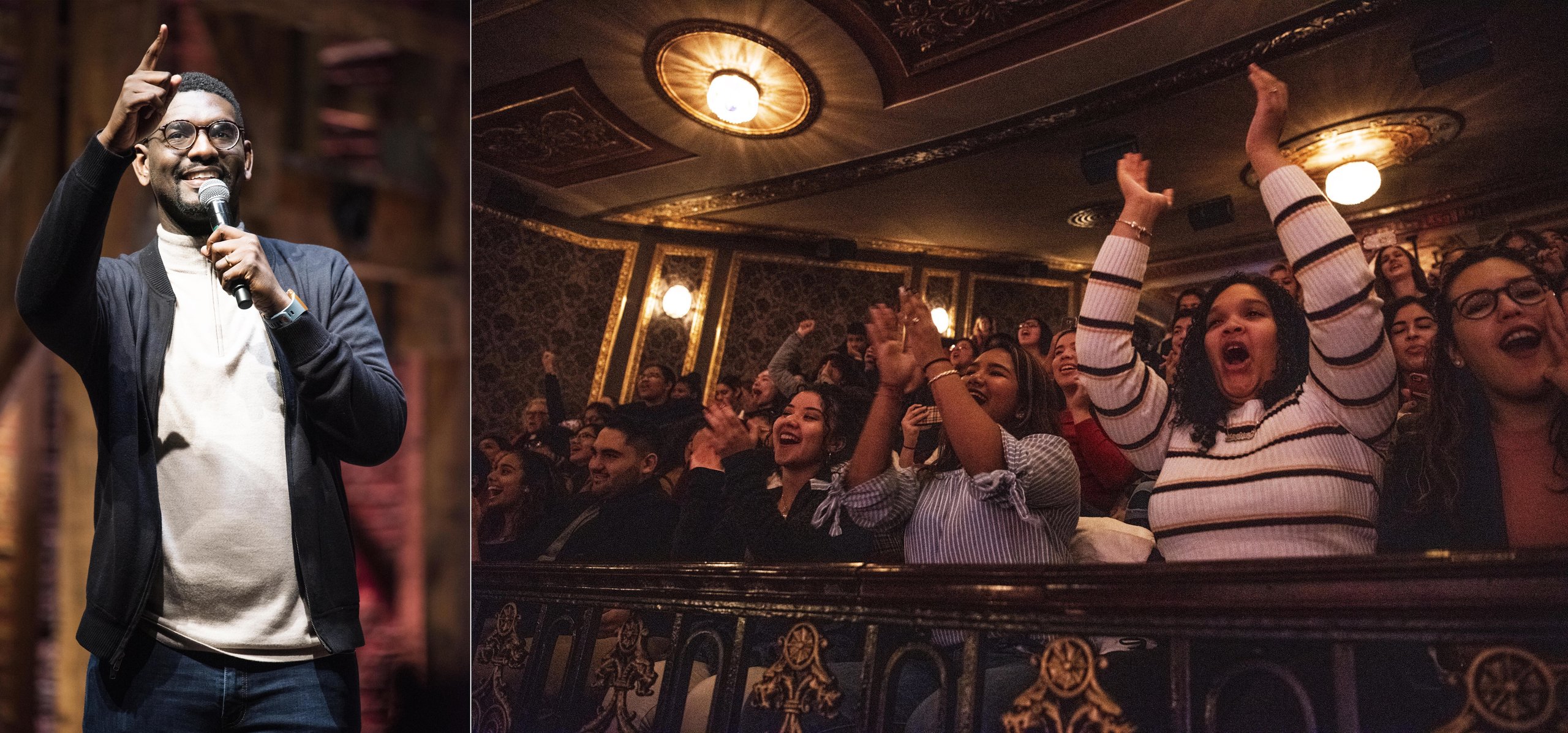
Damon Dahlen/HuffPost
“When life gets hard, you push through and finish,” he said. “When a test gets hard, you push through and finish.”
Hours later, when he marched onstage as Washington to “Here Comes the General,” the kids jumped up and screamed for him as if he were a pop star. Performing for an audience of black and brown high school kids is his favorite thing to do; it gives him a special kind of energy onstage. He said he hopes that seeing “Hamilton” can do the same thing for the next generation that “In the Heights” did for him as a young black man.
He almost fell out of character at one point. It was during the scene in which Hamilton and his wife, Eliza, kiss passionately in front of the audience. For a moment Lissaint saw what was happening onstage with his own eyes, not those of his character. Something quietly radical was taking place, right there in front of a roomful of teenagers, many of them black and brown. Two black people were on a Broadway stage, locked in an affectionate embrace. The teenagers in the audience whistled and cheered.
“It’s just so unseen to have two black bodies loving on each other on a Broadway stage,” he said. “We were all standing there, and we’re like, yo ― this is revolutionary right now.”
CORRECTION: A previous version of this story mischaracterized the role of Broadway for Black Lives Matter Collective in producing a second show at Feinstein’s/54 Below. The group offered to help with the show, but did not spearhead the project.
[ad_2]
Source link

